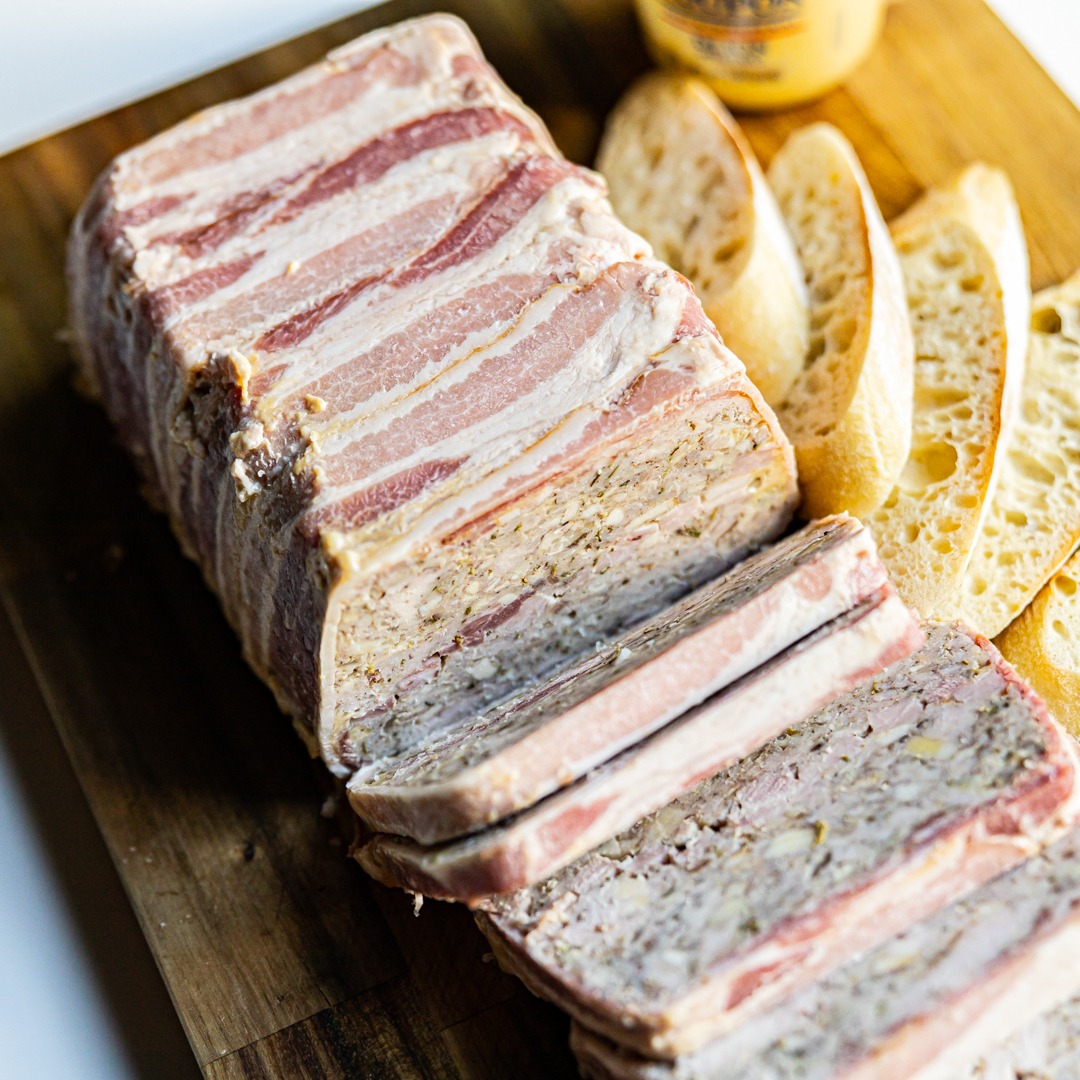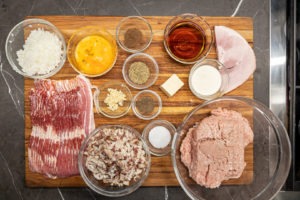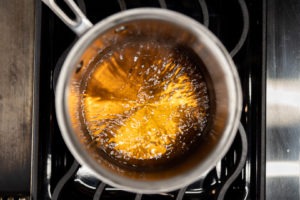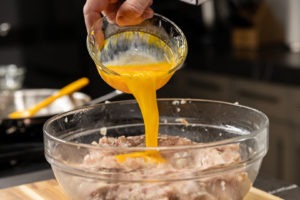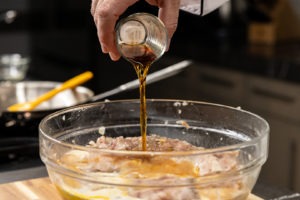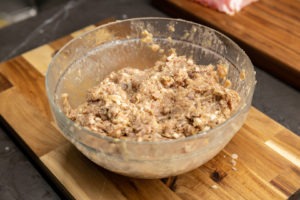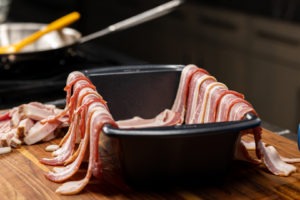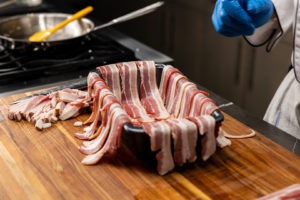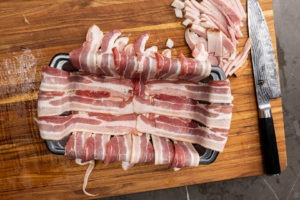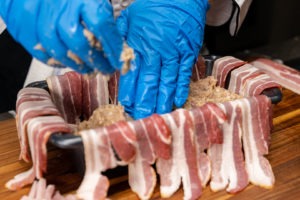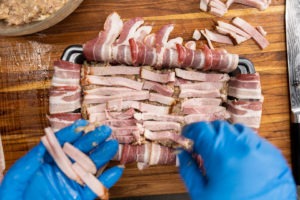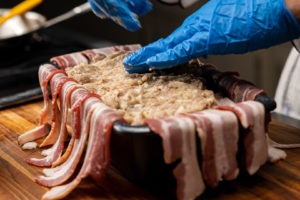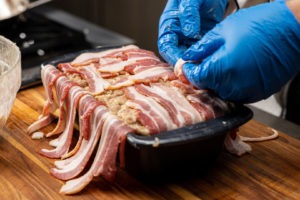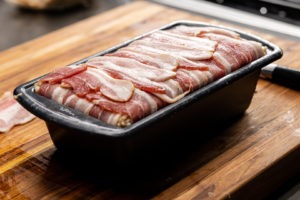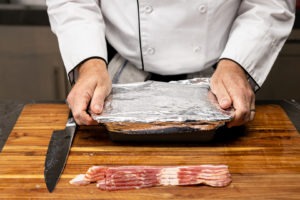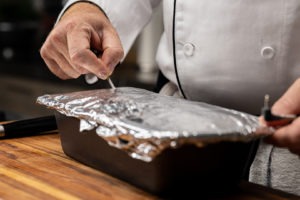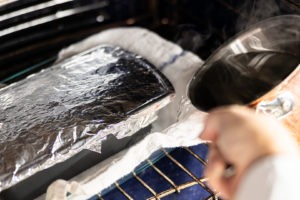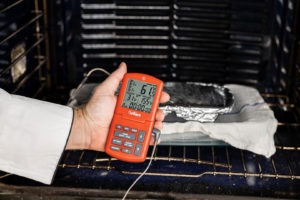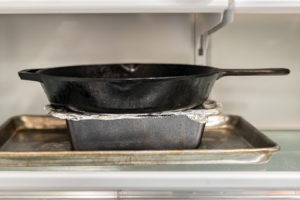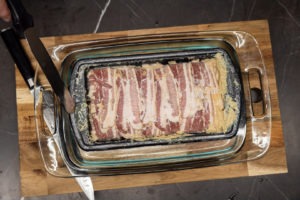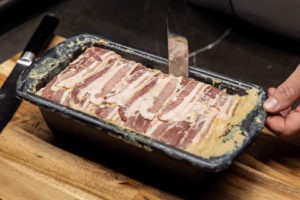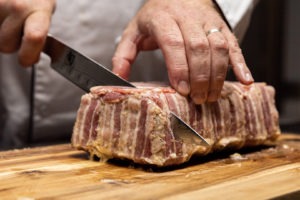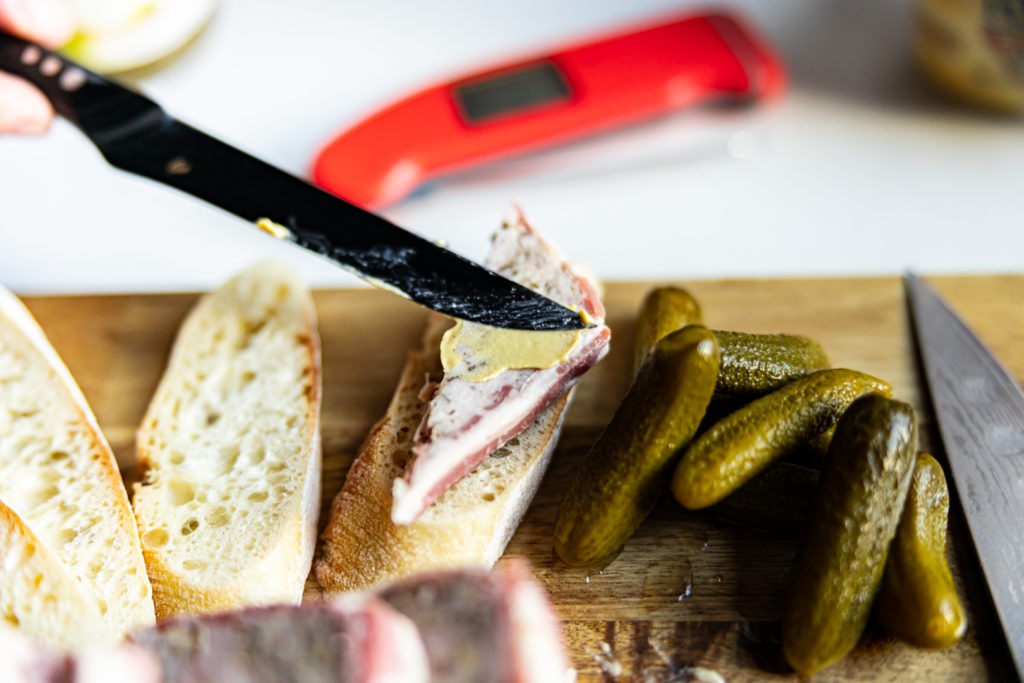Country Pâté: Bacon-Wrapped Meatloaf Gets Dressed Up—and Properly Temped
If I were to tell you that this blog entry’s recipe would be for a bacon-wrapped pork meatloaf that also has bacon mixed into it and is seasoned with a splash of booze, would you be excited? Good! Because French pâté de campagne is exactly what we’re talking about!
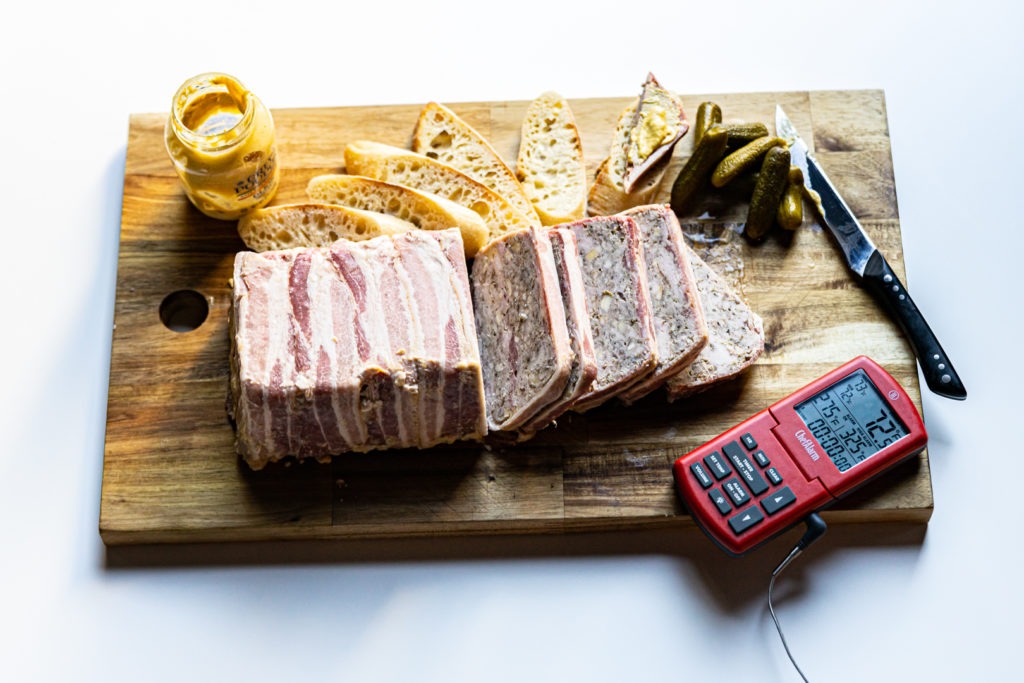
Pâté de campagne pull temp: 155°F
There’s no need to worry here that we’re talking about something inaccessible or too fancy. This is solid, country-living farmer food, just from a solid, country farm in another country. This pâté is amazing for anything from a simple supper with homemade bread to a buffet board at a potluck to a full-on Christmas feast. Don’t be intimidated by the name—good pâté is as easy to make as careful temperature measurement. Read on to find out more.
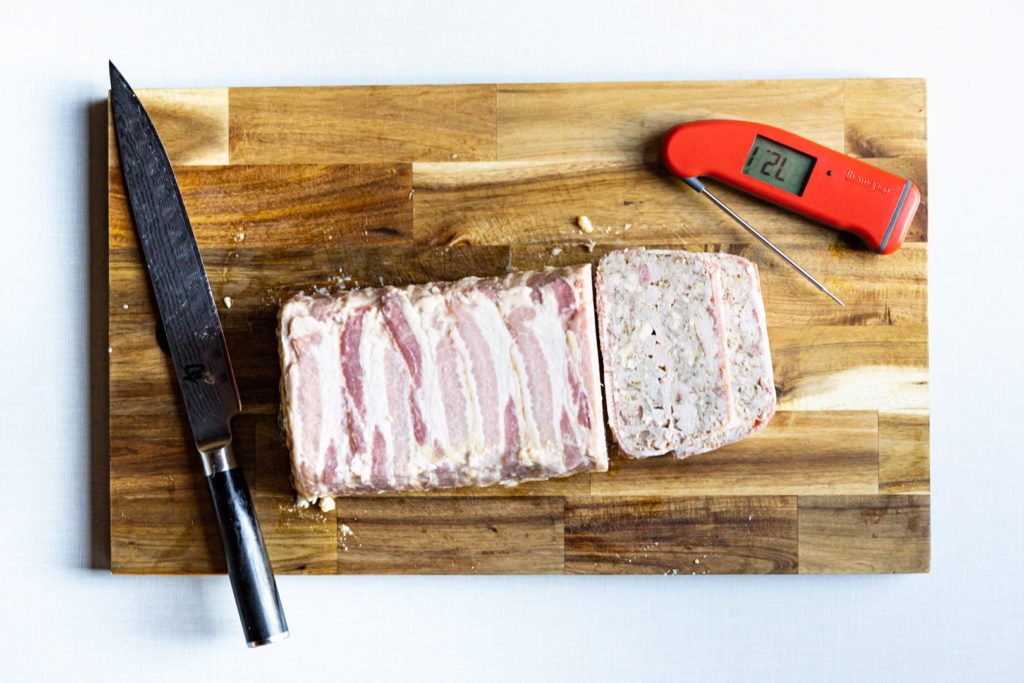
What is pâté?
In the most literal sense, pâté means “paste,” a reference to the manner of making various pâtés—they are finely chopped or ground, making a paste of the meat.
Pâté de campagne (pa-tay duh com-pan-yuh) translates as “country pâté,” and lies well on the rustic end of the spectrum. This is a dish that families would make, for instance, after slaughtering and processing their own hog every year. It’s made of ground pork that is seasoned with onions and chopped bacon, with an internal decoration made of sliced ham steak. The whole thing is wrapped in bacon and cooked slowly and carefully so that it gets up to “done” while not breaking any of the emulsions that form during assembly.
Pâté de campagne cooking temps
Pâté isn’t like just any meatloaf, when it comes to cooking. While it’s true that we don’t want to overcook any meatloaves, the pâté feels overcooking more strongly because it is eaten chilled and then brought back up to room temperature. There is no fresh-cooked-juiciness going on with this! To help prevent overcooking, the pâté is cooked in a pan set in a water bath in the oven. The hot water acts as a thermal barrier to the meat (the water won’t get any hotter than the local boiling point), while also transferring heat to it more directly (the conduction of heat through water is more efficient than the convection of heat from the air). A bath of nearly-boiling water in a 350°F (177°C) oven will do the trick nicely to get it up the the temperature we want.
And what temperature do we want? Cook your pâté to 155°F (68°C) before pulling it from the oven. Remembering that bacterial kill-off is a function of time in addition to temperature, the slower approach to the pull temp that is afforded by the water bath will give the meat enough time in the slower bacterial kill zone to make it safe.
Serving pâté
As I hinted above, pâté needs to be chilled for several hours (preferably overnight). This gives it a cohesive, sliceable texture and allows the flavors to meld and develop. But the high fat content of pâté (did I mention that the bacon-y pork is bound together with eggs and cream? No?) means the flavors are dulled when cold. For the best flavor, the pâté should be removed from the refrigerator about an hour before serving.
Those rich meaty fatty flavors also call for bright backup. Sharp mustard, tart pickles, and even raw onion are wonderful accompaniments to the pâté, as is good bread. Slice the pâté into slabs and serve it up.
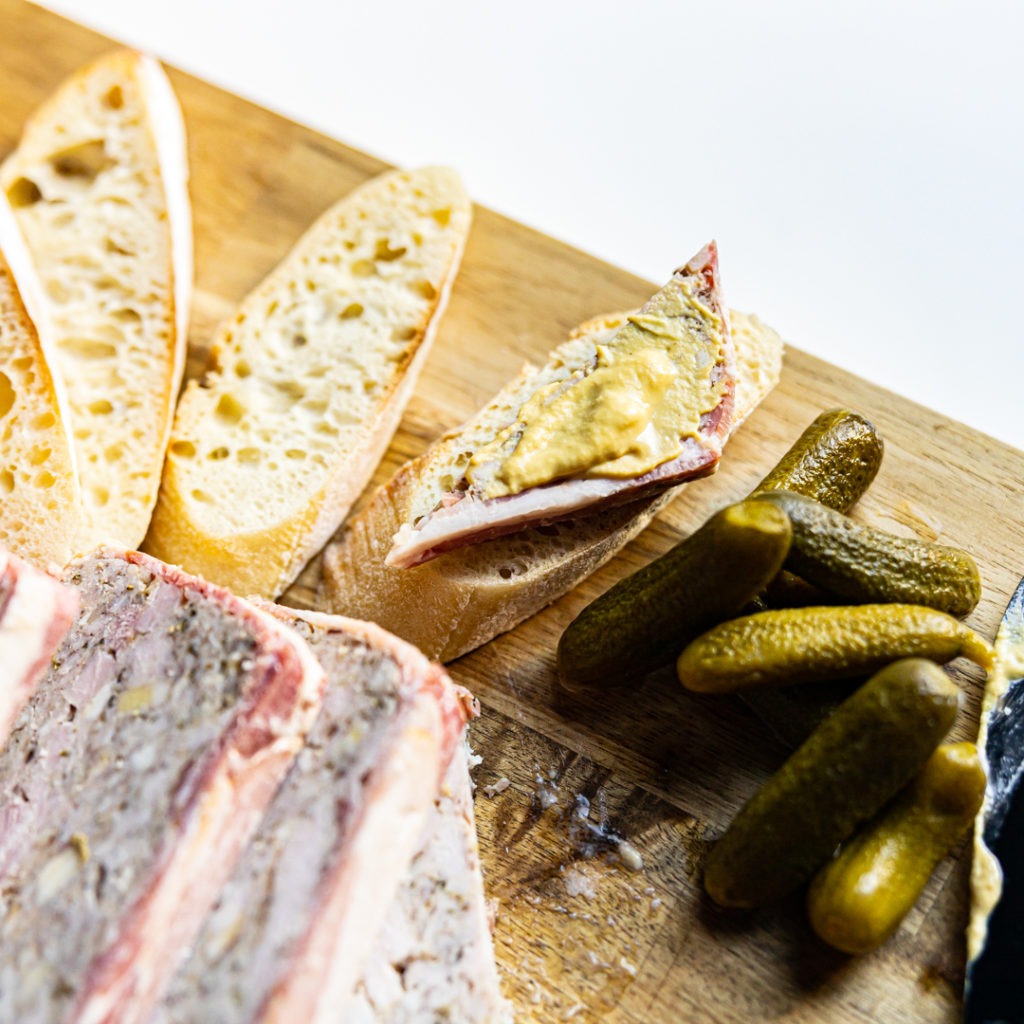
Don’t let the fancy name fool you; this rugged, meaty dish is easily within your reach. With the help of a ChefAlarm, you can make perfect pâté for your seasonal celebrations as good as any French farmer. And you’ll be glad you did!
Print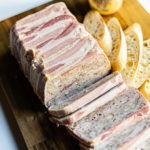
Pâté de Campagne recipe
Description
A rustic French country pâté, based on one from Bon Appétit.
Ingredients
- 3/4 C Cognac or other brandy
- 3 Tbsp unsalted butter
- 1 C minced onion
- 2 1/2 lb ground pork
- 28 slices bacon (not thick cut), divided: 18 set aside for lining the pan, 10 finely chopped for mixing into the pâté
- 3 garlic cloves, minced
- 2 1/2 tsp salt
- 2 1/2 tsp dried thyme (or 7 1/2 tsp fresh thyme)
- 1 1/2 tsp allspice
- 1 tsp freshly ground black pepper
- 2 large eggs, lightly beaten
- 1/3 C whipping cream
- 1 6-oz piece ham steak, cut into 1/4-inch strips
For serving: dijon mustard, cornichon pickles, good bread, extra salt for sprinkling
Instructions
- Pour 1/2 C of the brandy into a small saucepan. Note the level on a chopstick or a wooden spoon. Add the rest of the brandy and boil to reduce down to the 1/2 C level. Remove from heat and allow to cool.
- Melt the butter in a sauté pan and sauté the onion until translucent and softened. A little browning is ok, but try to avoid much. Set the onion aside to cool.
- In a large bowl, combine the ground pork and chopped bacon. Mix to blend well.
- Add the cooled onion, the salt, thyme, allspice, garlic, and pepper. mix to distribute evenly.
- Add the eggs, reduced brandy, and cream to the mixture. Mix everything well.
- Prepare a standard bread loaf pan by lining it with the slices of bacon. 6 slices will go on each of the long sides of the pan, each slice extending across the base, up the wall, and over the edge of the pan. Three slices will line each short side of the pan. (They needn’t cover the length of the base, just reach to the center.)
- Pack about 1/2 of the pâté mixture into the pan, trying to eliminate any air pockets.
- Lay the strips of sliced ham steak over the surface, oriented along the length of the pan.
- Add the rest of the pâté mixture on top, packing it down. If you have more than can fit in the pan, set it aside. You can cook it up as sausage patties and eat it with toast while this cooks.
- Starting at the short sides of the pan, fold the overhanging bacon up over and onto the pâté mixture. Then fold the bacon from the long sides up and onto the loaf.
- Wrap the top of the loaf pan tightly in foil. Insert the probe of a ChefAlarm into the very center of the pâté. Set the high-temp alarm on the ChefAlarm for 155°F (68°C).
- Boil a quart or so of water.
- Place the pate dish in a cake pan in the oven and pour the boiling-hot water into the pan, as deep as you can without spilling over the edge.
- Cook the pâté until the high-temp alarm sounds (about 2 hours). Verify the temperature with your Thermapen.
- Remove the loaf pan from the oven and set it on the counter to cool somewhat. Place the loaf pan on a rimmed baking sheet in the refrigerator and weight the top of the pâté with a heavy cast iron pan or a plate with some large cans on it. This pressing as it cools will help its texture.
- Chill overnight.
- Remove the pan from the refrigerator at least an hour before you want to eat. Remove the foil. (You can tent the foil lightly over it at this point, but you don’t want it wrapped tight.)
- Warm the bottom of the pan in a bath of hot (not boiling) water. Run a thin-bladed spatula or knife around the edge around the inside of the pan and invert it onto a cutting board. The whole pâté should come out. If it sticks, cajole it with a thin spatula.
- Present it whole, allowing people to slice their piece fresh. Enjoy with crusty bread, mustard, pickles, and good company.
Shop now for products used in this post:


